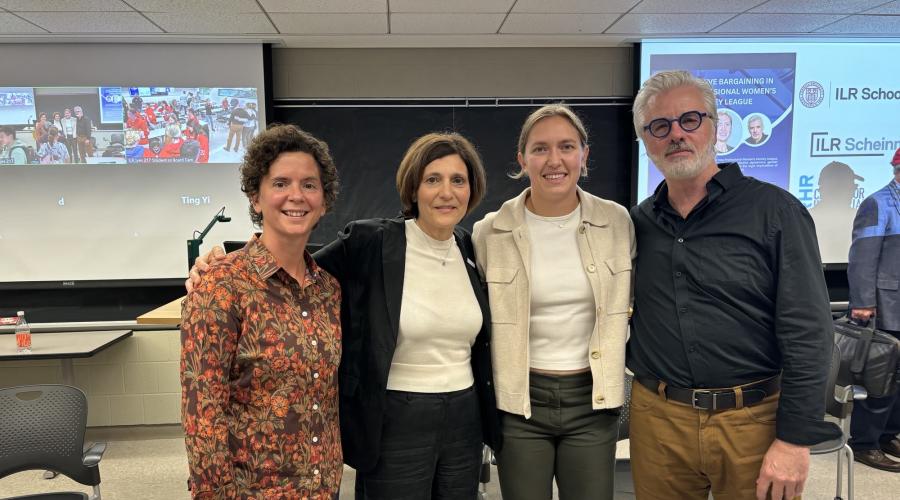
ILR Panel Discusses Collective Bargaining in Women’s Professional Hockey
A discussion focused on the evolution of, and challenges facing, women’s professional hockey was hosted on Monday by ILR International Visiting Fellow Kelly Pike, ’03, Ph.D. ’14, in Ives Room 217.
A former Big Red women’s hockey player, Pike was joined by Cornell Hall of Famer Digit Murphy, CALS ’83, two-time Team Canada Olympic hockey gold medalist Brianne Jenner, A&S ’15, and David Doorey, professor of law and director of the Sports Management Program at York University in Toronto.
“The idea for this event came to me while watching a Cornell women’s ice hockey game last winter at Lynah Rink,” Pike said. “I was sitting with some labor scholar colleagues, as well as several ladies from my local hockey team in town. Everyone was super excited about the new Professional Women’s Hockey League. They were talking about how much support the league was getting in terms of sponsorships, live streaming, selling out big rinks, and wondering how we could get up to watch some nearby games in Ottawa or Montreal or New York.
“We were also talking about the league’s collective bargaining agreement and some of the terms and conditions in there, like the salaries for example, which were higher than ever before for women’s professional hockey. But there was discussion about whether these salaries were fair and equitable in the CBA – with a range of $30,000 to $90,000 – and especially as compared to the men, who make millions.”
Jenner, who captains the league’s Ottawa Charge and is on the board of the PWHL Players’ Association, which was responsible for negotiating the league’s first CBA – collective bargaining agreement – opened the discussion by giving a history of women’s professional hockey in North America. She explained how the folding of the Canadian Women’s Hockey League came as a “shock” to the players, but the timing – which came during the 2019 World Championships – was fortuitous.
“We were at the World Championships, and the leaders on the U.S. team and the leaders on the Canadian team actually got together for coffee, which is, if you know how bitter the rivalry is amongst those teams, that’s a pretty crazy occurrence,” Jenner said. “We made the decision that we had to do something to build something more sustainable. We had had so many iterations of professional women’s hockey that just hadn't been able to be sustained. And from that point on, we began our [players’] association.”
The Professional Women’s Hockey Player Association had just over 100 players join that first year, and the leadership asked the players to refrain from playing “meaningful” hockey – eschewing the Premier Hockey Federation – as a way to gain momentum and create a movement. They went on tour across North America to attract corporate sponsors and then used that money to build a model that they could then shop to investors.
The league’s primary investor, Dodgers co-owner Mark Walter and his wife, Kimbra, came on board in the spring of 2022 and the players’ association was able to begin negotiating their first agreement.
“One of the biggest challenges that we had going into that process was a lack of leverage,” Jenner said. “In a lot of ways, we are running up against a really difficult timeline. We had been an association going on four years, and it was difficult. Players wanted to play hockey, and [we were] asking players to not play meaningful games in prime years of their careers. So, we knew that we didn't have a whole lot of time to get something done
“At the same time, there were some pillars in our negotiation that we just knew we couldn't budge on because we needed a strong foundation for the league. To give you an example, name, image and likeness. That was something that we needed to reserve for our players. We felt it wouldn't be right or fair, or the right kind of footing to begin a league on, to sell that away. So, as much as we didn't have leverage, there were a few things that we knew we had to put our stake in the ground and trust that just the power of us staying united would be enough.”
Doorey provided insight for the ILR crowd, explaining the “nuts and bolts of cross-border negotiating for leagues that include both Canadian and American teams,” Pike said. His insight led to an interesting back-and-forth about the implications of different laws, not just between the U.S. and Canada but also between Canadian provinces, and how they can affect future collective bargaining agreements.
Murphy, who has been involved with developing professional women’s hockey for decades and has seen leagues in North America form and collapse, spoke from the personal experience of growing the game on a grassroots level and preached caution.
“I’m an advocate,” Murphy said. “I’m a women’s opportunity creator. That’s why I’m on the planet. So, how do we build more community-based models where people are involved together, working with [the league] to make an impact on local schools? How do we get public-private intersection money?
“We want to see the league go from six to 12 [teams]. Maybe the Caitlin Clark effect will take hold of women's hockey, but it's going to take time. But we're on the right track. We're going to get there. We just have to work together.”
The panel was co-sponsored by the ILR School, ILR’s Scheinman Institute, York University Sports Management Program, the University of Toronto Centre for Industrial Relations and Human Resources and the Canadian Industrial Relations Association.